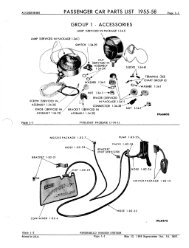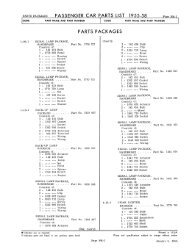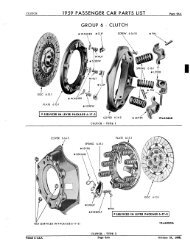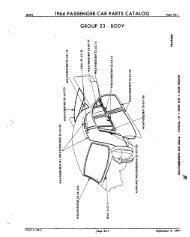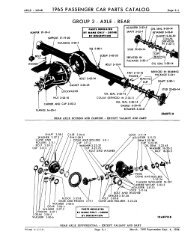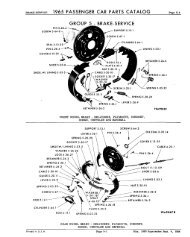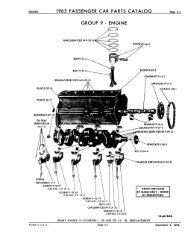Group 3 - Rear Axle - Copyright © jholst.net, all rights reserved.
Group 3 - Rear Axle - Copyright © jholst.net, all rights reserved.
Group 3 - Rear Axle - Copyright © jholst.net, all rights reserved.
Create successful ePaper yourself
Turn your PDF publications into a flip-book with our unique Google optimized e-Paper software.
4—REAR AXLE<br />
1. REAR WHEEL NOISE<br />
a. Wheel loose on axle shaft.<br />
b 8 Wheel hub bolts loose.<br />
c. Improper shimming at axle bearing.<br />
d. Insufficient lubrication.<br />
e. Brinnelled or scored wheel bearings.<br />
f. Worn drum or worn axle shaft keyways.<br />
g. Bent or sprung axle shaft.<br />
2* REAR AXLE NOISE<br />
a. Lubricant level too low.<br />
b. End play in drive pinion bearings. Also see<br />
Paragraph 3b—gear noise on coast.<br />
c. Excessive gear lash between ring gear and<br />
pinion. Also see Paragraph 3a and c. Gear noise on<br />
pull.<br />
d. Loose drive pinion companion flange nut.<br />
e. Scuffed gear tooth contact surfaces.<br />
3. REAR AXLE GEAR NOISE<br />
a. Gear noise on pull—a heavy pitch noise and<br />
increases as car speed increases, indicates scored gear<br />
teeth due to loss of lubricant, excessive gear lash<br />
or wrong type of lubricant.<br />
b. Gear noise on pull or coast—noise is heavy and<br />
(irregular) indicating excessive end play in pinion<br />
bearings.<br />
Co Bearing noise on pull or coast—a rough grating<br />
sound may change slightly in volume as speed<br />
changes; indicates that the rear axle pinion bearings<br />
are chipped, cracked, scored, badly worn and loose,<br />
or no gear lash.<br />
4 CLICKING NOISE IN DRIVE LINE<br />
a. Noise in drive line when vehicle is backed up<br />
or moved forward — Clean axle shaft taper, keys<br />
and drums. Apply a heavy coating of chalk around<br />
entire circumference and length of the tapered section<br />
of rear axle shaft. Inst<strong>all</strong> drums and tighten<br />
axle shaft nuts 145 foot-pounds torque, minimum.<br />
SERVICE DIAGNOSIS<br />
Check universal joints, and flange splines. Tighten<br />
companion flange nut to 240 foot-pounds torque,<br />
minimum.<br />
5. REAR AXLE DRIVE SHAFT BREAKAGE<br />
a. Improperly adjusted wheel bearings.<br />
b. Abnormal clutch operation.<br />
c. Misaligned axle housing.<br />
d. Vehicle overloaded.<br />
6. DIFFERENTIAL CASE BREAKAGE<br />
a. Improper differential bearing adjustment.<br />
b. Abnormal clutch operation.<br />
c. Excessive drive gear clearance.<br />
d. Vehicle overloaded.<br />
7. D1FFRENTIAL SIDE GEAR BROKEN<br />
a. Worn thrust washers.<br />
b. Misaligned or bent axle shaft.<br />
c. Overloading vehicle.<br />
8* TOOTH BREAKAGE (Drive Gear and Pinion)<br />
a. Overloading and abnormal clutch operation.<br />
b. Improper gear adjustment.<br />
9. OVERHEATING OF AXLE UNIT<br />
a. Lubricant level too low.<br />
b. Bearings adjusted too light.<br />
c. Bearings adjusted too tight.<br />
d. Excessive wear in gears.<br />
e. Insufficient drive gear to pinion clearance.<br />
10. LOSS OF LUBRICANT<br />
a. Lubricant level too high.<br />
b. Clogged breather.<br />
c. Scored or worn parts.<br />
d. Oil seals worn.



